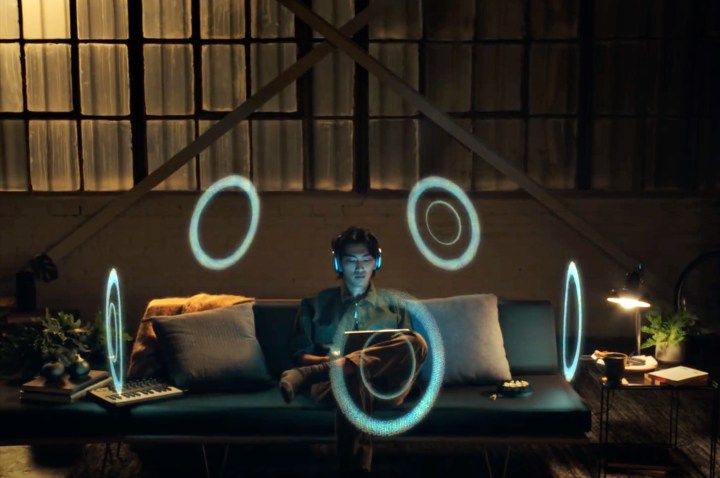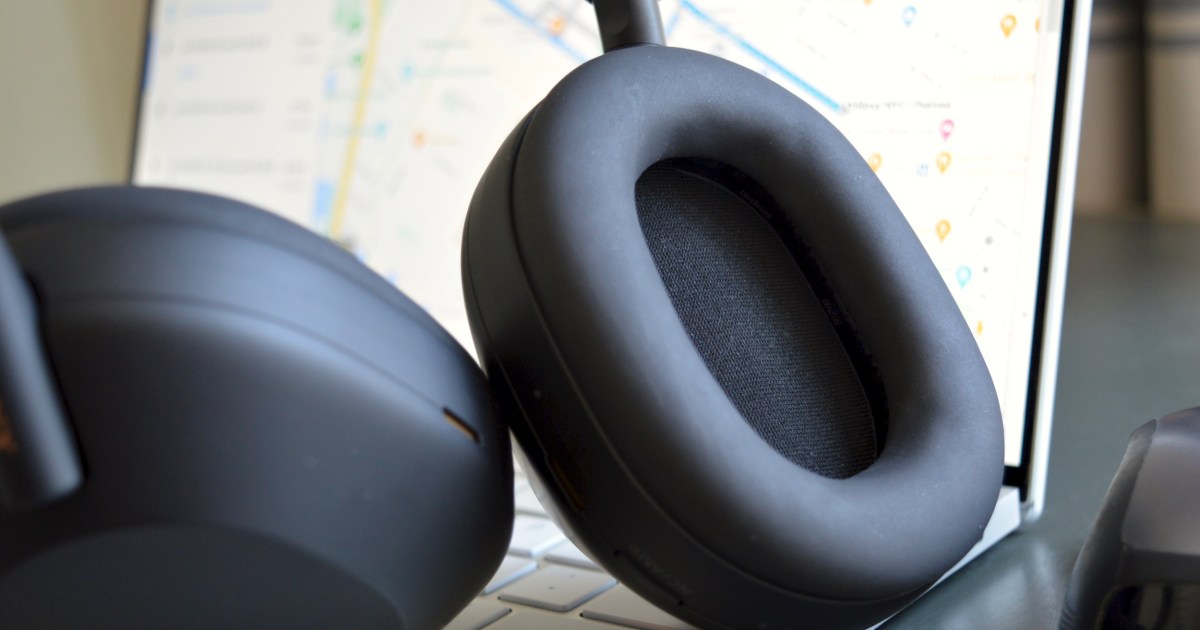Noise-cancelling headphones and earbuds are a godsend. If you’ve ever owned a pair, you’ll know their ability to create a peaceful, noise-free listening experience that’s excellent for listening to music, blocking out commute noise, and even working. And if you’re thinking of investing in a set, you’re in for a treat. Of course, not all noise-canceling products are created equal, but many of these devices are unified by some common audio tech. One feature that a number of these headphones and earbuds use is something called active noise-cancellation, or ANC.
When it comes to noise cancellation, you can think of ANC as the foundation. But how exactly does this impressive circuitry and sound processing work? What does the jargon mean? Who are the big players? We’re here today to give you a crash course in ANC and its many audio offshoots.
What is active noise cancellation?

If you ever took an Introduction to Physics class in high school or college, you may remember a section that covered waves. Waves made of water, or light, or sound all share a few intrinsic properties. ANC technology takes advantage of one of these properties: Any wave can be effectively “canceled” if you create a second wave that is the exact opposite of the first wave — a process known as destructive interference.
So if you can create a set of headphones that can listen to the outside world and instantly create a set of sound waves that are the exact opposite of the sound waves it hears (a.k.a. anti-noise), then, in theory, you wouldn’t hear the external sounds at all — they would have been canceled before ever reaching your eardrum. That’s exactly what ANC does.
Bose, the company that developed the first commercial ANC headphones for pilots, and then the first ANC headphones for the general public, describes it like so:
With microphones inside and outside the earcups, Bose noise-cancelling headphones continuously sense, measure, and send unwanted sounds to proprietary digital signal processing chips which compute a precise, equal, and opposite signal to react to changing noise in less than a fraction of a millisecond. The result is surrounding noise all but vanishes.
Not all ANC is created equal, however, which means that even though all ANC headphones and earbuds use this same principle, there can still be big differences between brands and models.
Active versus passive noise cancellation

As great as ANC can be, it’s worth noting that it’s not the only way to deal with noise. Passive noise cancellation (sometimes called passive noise isolation) takes a decidedly low-tech approach to the problem by creating a physical barrier between your eardrums and external sounds.
It’s usually accomplished by creating a tight seal around your ear (if it’s a set of headphones) or inside your ear canal if you’re using earbuds. Either way, the result is the same: You won’t hear a sound that can’t make it to your eardrums in the first place. When passive noise cancellation is done well, it can be so effective that you don’t feel the need for anything else.
It’s also worth noting that despite using different approaches, active and passive noise cancellation are actually complementary to one another. The more sound you can passively block, the better ANC technology can cancel the sounds that still make it through.
Think of it like paint: If you use a coat of primer on your walls, you’ll probably need fewer coats of paint to get the color and coverage you want, than if you simply applied the paint directly.
What’s the difference between ANC and ANR?
You may have seen the term Active Noise Reduction, or ANR, in addition to the more common ANC. In practice, there’s no difference between them. Each company uses its preferred label, but it’s the same feature.
Interestingly, Bose uses both terms, but in different circumstances. When Bose makes its own noise-canceling headphones, it calls them ANC, because Bose has been 100% responsible for how those headphones perform. But sometimes third-party companies will license Bose’s noise-canceling technology to create their own ANC headphones. Amazon did this when it introduced its first-generation Echo Buds. When that happens, those third parties use the term ANR to refer to Bose’s contribution, as a way of indicating that Bose wasn’t involved in every aspect of the headphones’ performance.
How do ANC headphones and earbuds work?

Some ANC models use “feedforward” microphones. These mics are placed on the outside of the headphones, where they’re able to pick up external sounds clearly and quickly. But feedforward ANC systems don’t know what happens to external sounds as they pass through the noise-isolating barrier of the earcups (or ear tips). This means that the anti-noise they produce may not be a perfect match for the noise that enters your ears.
Other ANC systems use “feedback” microphones, which sit inside the earcups of the headphones. They get the most accurate reading on the external sounds that have penetrated the headphones, so they should be able to create the most accurate anti-noise. But these systems aren’t as adept at canceling high-frequency sounds as feedforward mics. They also have to contend with any music you’re listening to. Being able to distinguish between the sound you want to hear (your music) and the sound you want to cancel can be tricky, and feedback systems run the risk of canceling out some of your music.
As you might expect, the best ANC systems use a hybrid of the feedforward and feedback models and use both internal and external microphones to combat noise. If you see a set of headphones that list “Hybrid ANC,” it uses this method.
Adaptive ANC
A relatively new term in the headphone space, Adaptive ANC can mean different things depending on the model of headphones and the technology being used.

Even if you get a great seal with a set of earbuds, as you walk, run, or even talk, the earbuds will naturally shift around inside your ear, causing that seal to change. Qualcomm’s Adaptive ANC responds to these changes.
Another form of Adaptive ANC relates to the algorithms used by the ANC circuitry. External sounds are constantly changing based on our environment. Indoors, we probably encounter lots of people speaking, while outdoors we could be faced with traffic sounds, and on an airplane, it’s mostly the white noise of a jet’s engines. Many companies offer smartphone apps that let you select the appropriate ANC mode based on your surroundings, but Adaptive ANC systems attempt to analyze those changing sounds and shift modes automatically so that you’ll always have an optimized noise-canceling experience.
What makes one set of ANC headphones better than another?
This is the million-dollar question. The honest answer is everything. ANC is much more than just external and internal microphones combined with some circuitry. It’s the number, placement, and kind of microphones used. It’s the quality of the electronics used to tie the components together. It’s the sophistication of the noise-canceling algorithms, and it’s the sensitivity of the drivers used to produce both sound and anti-noise.
Because ANC is so complex, buyers need to beware of manufacturer claims like the amount of noise canceled as expressed in decibels (dB). You may see a set of ANC headphones that claims to cancel -35dB of noise. But what does that mean? Unwanted sound isn’t just measured in loudness — it’s also composed of a spectrum of frequencies. If the ANC system reduces high-frequency sounds by -35dB, but hardly reduces low-frequency sounds at all, is that good or bad? If you’re trying to block out the sounds of the neighbor’s kids (or maybe your kids) shrieking while they play, it could be very helpful. But since most of us aren’t going to want to wear different headphones to block different noises, it’s probably not the right choice.
Our advice, you will not be surprised to hear, is to read reviews, both professional and buyer-based, to learn how your chosen model deals with a variety of situations.
What can I expect from a good set of ANC headphones?

Any ANC headphones or earbuds that are worth having should produce an immediate and very noticeable reduction in external noise. Most ANC headphones also have a transparency mode too, which is designed to let lots of noise in (so you can maintain awareness of hazards or have conversations without removing the cans). In an ideal world, transparency mode makes you feel like you aren’t wearing headphones at all.
When you turn transparency and ANC off, things should get much quieter, but you’ll still be fairly aware of outside sounds. Turning ANC on should substantially reduce those remaining sounds. In some cases, ANC can make a sound (like the droning of a fan) disappear completely, leaving you with an almost perfect sense of calm and quiet.
What are some signs of bad ANC headphones?
The first and most obvious sign is that switching the ANC function on does little to dampen the sounds you were hearing before switching it on. This may seem obvious, but we’ve tried some models where it was almost impossible to tell when ANC was engaged.
Another problem is that ANC can start to affect the quality of your music. Remember, the same speakers that produce your tunes are also producing the anti-noise that cancels unwanted sounds. If the ANC system is too aggressive, poorly tuned, or might be suffering from any number of other weaknesses, you may find that music sounds noticeably worse when ANC is turned on.
Finally, poorly designed ANC circuitry can actually introduce new noise even as it tries to cancel unwanted noise. This most often shows up as a hissing sound that you can hear when you’re not listening to any content. Playing music can mask this hiss, but if you want to use your headphones as an alternative to earplugs, that audible hiss is guaranteed to drive you crazy.
What about Environmental Noise Cancellation (ENC)?
When reading product descriptions, pay specific attention to terms like Environmental Noise Cancellation (ENC), Clear Voice Calling (CvC), or noise-canceling (without the “active”). These are all references to noise-canceling performed by microphone circuitry to diminish the effect of background sounds when you’re talking to someone on a call or using your headphones to record your voice.
It’s definitely a feature you want in a set of headphones or earbuds if you plan to use them for voice calls, but it is not a different form of active noise cancellation and it won’t make any difference at all to the amount of noise that you hear when listening to music, or just wearing the headphones.
Editors’ Recommendations

